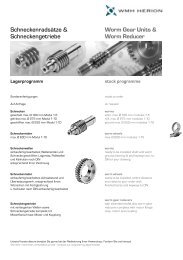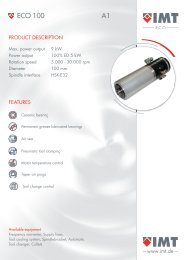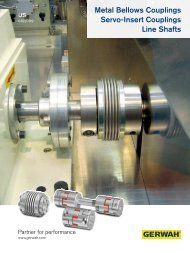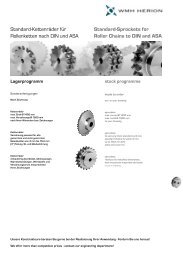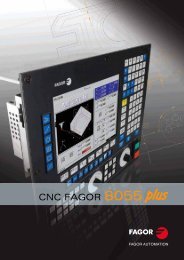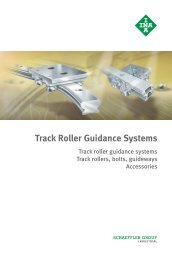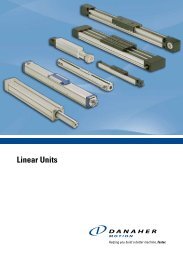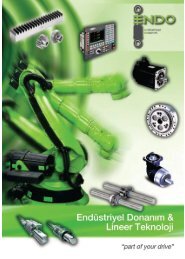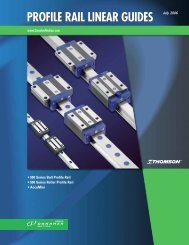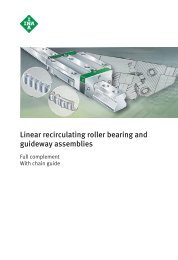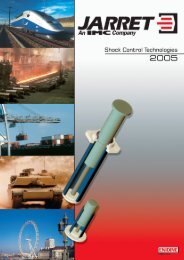slide guide
slide guide
slide guide
Create successful ePaper yourself
Turn your PDF publications into a flip-book with our unique Google optimized e-Paper software.
SLIDE GUIDE<br />
ACCURACY MEASUREMENT METHOD<br />
RIGIDITY AND PRELOAD<br />
The accuracy of <strong>slide</strong> <strong>guide</strong>s is measured by fixing the rail to the reference base. The accuracy is expressed<br />
in terms of the average value at the center portion.<br />
Dimensional Tolerance and Paired<br />
Difference<br />
The accuracy of the <strong>slide</strong> <strong>guide</strong> is obtained by<br />
measuring the height H, and width W, as shown in<br />
Figure A-1. The dimensional tolerance is measured<br />
for each of the blocks attached to the rail and is<br />
expressed in terms of the deviation from the basic<br />
dimension. The paired difference is obtained by<br />
measuring the blocks attached to the rail and is<br />
expressed in terms of the difference between the<br />
maximum and minimum values.<br />
Motion Accuracy<br />
The rail is first fixed to the reference base. The<br />
motion accuracy is obtained by measuring the<br />
difference in the indicator readings when the block<br />
is moved along the entire span of the rail.<br />
Note: Gauge head is placed on the center of the<br />
block reference surface.<br />
Figure A-1 Accuracy Measurement<br />
reference<br />
surface<br />
H<br />
W<br />
NB mark<br />
Figure A-2 Measurement Method for Motion Accuracy<br />
reference<br />
base<br />
The rolling elements of the <strong>slide</strong> <strong>guide</strong> deform<br />
elastically due to the applied load. The amount<br />
of deformation depends on the type of rolling<br />
element. It is proportional to the 2/3rd power for<br />
ball elements. For rollers, it is proportional to the<br />
0.9th power. In either case, the rate of deformation<br />
decreases as the applied load increases. Greater<br />
rigidity is achieved by applying a preload.<br />
A preload causes internal stress within the <strong>slide</strong><br />
<strong>guide</strong> block, resulting in some reduction in lifetime.<br />
However, when the <strong>guide</strong> is used under shock or<br />
vibration loading conditions, a preload will absorb<br />
the load and will actually help lengthen the life time.<br />
Because the preload causes elastic deformation of<br />
the rolling elements, it becomes less tolerable to the<br />
installation dimensional errors. Extreme care should<br />
be exercised in machining the installation surface.<br />
Four levels of preload are available: clearance,<br />
standard, light, and medium. This allows the user to<br />
select the appropriate level for the application.<br />
Table A-2 Level of Preload<br />
preload symbol vibration<br />
absorption ability<br />
self-aligning<br />
ability<br />
effect of preload<br />
lifetime<br />
rigidity<br />
Figure A-4 Elastic Deformation of Rolling Elements<br />
amount of elastic deformation <br />
B<br />
frictional<br />
resistance<br />
B<br />
R<br />
R<br />
P1: preload without preload<br />
P2: preload-effacing load<br />
P2R2 10/9 P1<br />
0 P1 P2R P2B<br />
applied loadP<br />
operating conditions<br />
with preload<br />
without preload<br />
with preload<br />
ball and<br />
curvature<br />
surface<br />
roller<br />
and<br />
at<br />
surface<br />
applicable<br />
part number<br />
SLIDE GUIDE<br />
Notation for Number of Axes and<br />
Paired Difference<br />
When more than one rail is used in parallel, the<br />
dimensional difference must be measured on more<br />
than one block on more than one rail. For measuring<br />
the paired difference for height H, please specify<br />
the number of axes (W2, W3) as the part number<br />
example shows. For measuring the paired difference<br />
for width W, please contact NB.<br />
Note : When four rails are used as illustrated in Figure A-3,<br />
W4 should be specified in the part number. Please indicate<br />
the number of axes when ordering.<br />
part number example<br />
SGL25TF2-350/ W2<br />
Figure A-3 4 Parallel Axes<br />
symbol for number<br />
of axes<br />
W2: 2 parallel axes<br />
W3: 3 parallel axes<br />
clearance T0<br />
standard blank<br />
light T1<br />
medium T2<br />
increases reduces reduces increases increases<br />
light motion is required.<br />
installation errors to be absorbed.<br />
minute vibration is applied.<br />
accurate motion is required.<br />
moment is applied in a given direction.<br />
light vibration is applied.<br />
light torsional load is applied.<br />
moment is applied.<br />
shock and vibration are applied.<br />
over-hang load is applied.<br />
torsional load is applied.<br />
SEB<br />
SEB,SGL<br />
GL,SGW<br />
SEB,SGL<br />
GL,SGW<br />
SGL,GL<br />
SGW<br />
A-4 A-5



